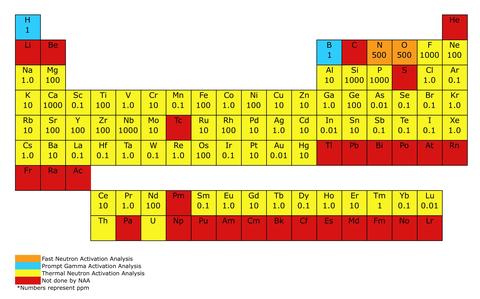Instrumental Neutron Activation Analysis (INAA)

Analytical capabilities and detection limits for elements by NAA
Instrumental neutron activation analysis (INAA), or sometimes referred to as simply NAA, is a method for determination of many elements at low levels in a wide variety of materials. Samples are usually encapsulated in polyethylene or some other suitable packaging, packed into an irradiation capsule (usually a polyethylene “rabbit”) and irradiated in the reactor core. Pneumatic tubes allow irradiation at two different reactor positions, at neutron fluence rates of 1 x 1014 cm-2 s-1 and 3 x 1013 cm-2 s-1. During irradiation elemental nuclei capture neutrons and produce radioactive nuclei. Since the neutron flux is highly thermalized, single neutron capture reactions are dominant. After a suitable decay period following irradiation, the nuclides of interest are determined by gamma ray spectroscopy using a high-resolution germanium detector with appropriate signal analyzer and electronics. Quantification of elements is accomplished by comparison with standards usually irradiated along with the samples.
Detection limits may be improved by the use of anticoincidence or coincidence counting techniques to improve signal to noise ratio. The use of loss free counting methods and high throughput detectors allow quantification at higher counting rates with minimal loss of signal or resolution, further improving detection limits. Detection limits may be further improved by optimizing irradiation, decay, and counting times to the half-life of the element of interest.
The analysis is essentially “blank free”, if the sample is repackaged after irradiation, and quantitative measurement of the bulk sample is obtained since the neutron and gamma radiation both penetrate the sample. Because the technique relies on nuclear, rather than chemical reactions, the results are not dependent upon the chemical form of the element. Samples may be analyzed without dissolution or decomposition, eliminating measurement errors due to incomplete dissolution or loss of volatile elements. And because the analysis is nondestructive, samples may be analyzed again by NAA or by other techniques if necessary. Because NAA shares few sources of uncertainty with purely chemical methods of analysis, it serves as an important complementary technique to these methods. Typical detection limits are at µg/g levels or better.

